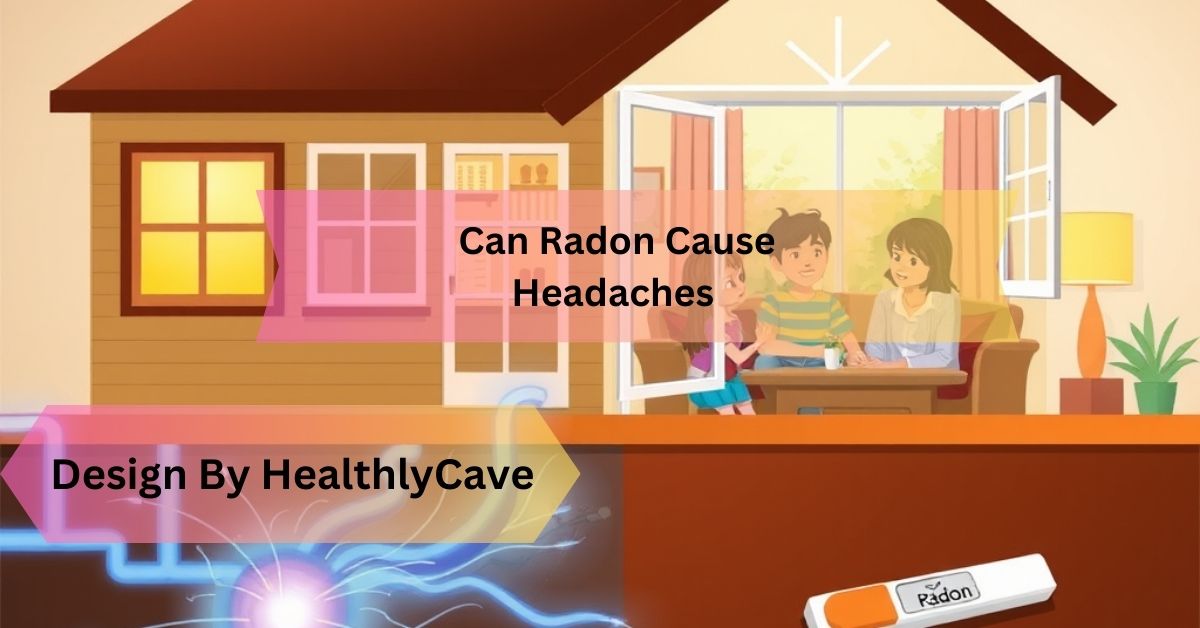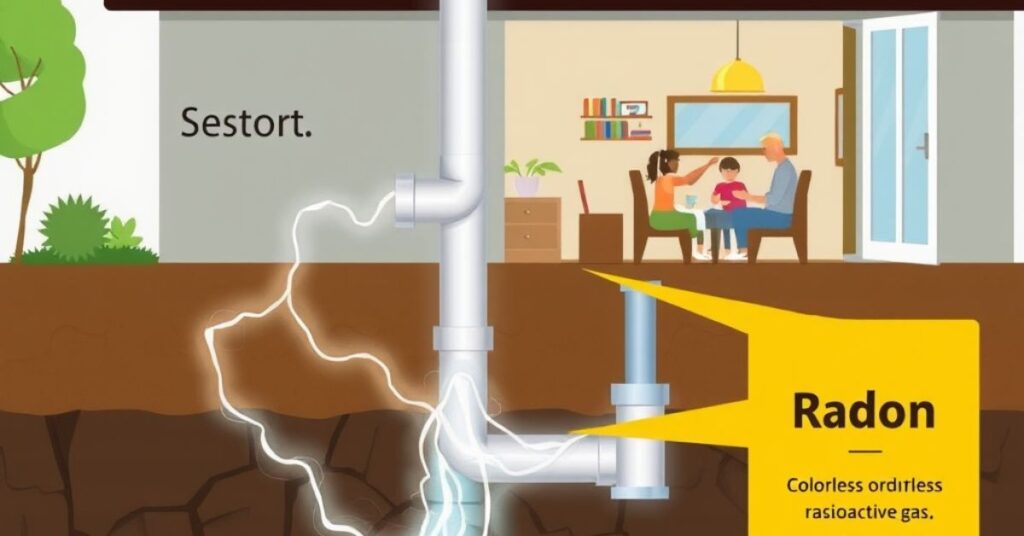
07 Feb Can Radon Cause Headaches – Understanding the Health Risks!
When we think about indoor air quality, we usually worry about things we can see, like dust or mold. But there’s one danger you can’t see, smell, or taste—radon. This harmful gas can build up in your home and cause serious health problems, including lung cancer. Some people wonder if radon can also cause headaches. While scientists are still studying this, it’s important to know how radon might affect your health. In this article, we’ll talk about what radon is, how it can impact your health, and how you can reduce your risk.
What is Radon?

Radon is a radioactive gas that is colorless, odorless, and tasteless. It is produced naturally when uranium in the earth’s soil, rocks, and water breaks down. Radon can seep into buildings through cracks in the foundation, gaps around pipes, and other openings. Since this gas is undetectable by sight or smell, many people may be exposed to it without realizing it.
The presence of radon varies by location, and its concentration can change depending on factors such as ventilation, weather, and the geological makeup of the area. Due to its radioactive nature, radon is considered a significant environmental health threat, especially in enclosed spaces where it can accumulate over time.
Can Radon Cause Headaches?
While radon exposure is mainly linked to lung cancer, some people report headaches after long-term exposure. Though scientific studies have not confirmed headaches as a direct symptom, radon can affect indoor air quality, leading to issues like:
- Poor oxygen levels
- Increased carbon dioxide levels
- General air pollution
These factors can contribute to headaches, dizziness, and fatigue, especially in poorly ventilated areas. Additionally, radon exposure might cause mild respiratory issues or general discomfort, which could indirectly lead to headaches due to a lack of fresh air and increased stress on the body.
Some people are more sensitive to changes in air quality than others. Those with preexisting respiratory conditions, allergies, or sensitivities to pollutants may experience symptoms sooner than others when exposed to radon. While the connection between radon and headaches is still being explored, improving indoor air quality can be beneficial for overall health.
Other Symptoms of Radon Exposure:
Long-term exposure to high levels of radon can lead to more serious health problems, including:
Lung cancer:
The leading health risk of radon exposure, caused by inhaling radioactive particles that damage lung tissue over time. Over years, the damage accumulates, increasing the likelihood of cancer. Early symptoms may not appear, making it difficult to detect until later stages. Radon-induced lung cancer is often more aggressive than other forms of cancer.
Chronic cough:
Irritation of the respiratory system due to prolonged inhalation of radon and other indoor pollutants. This cough may persist for weeks or months and worsen over time. It is often accompanied by mucus production, signaling a deeper issue. In severe cases, coughing fits can lead to chest discomfort and difficulty sleeping.
Shortness of breath:
Difficulty breathing due to lung damage or decreased oxygen levels. It may begin with minor exertion and gradually worsen over time. People affected may feel winded even while resting. Shortness of breath can lead to other complications, including dizziness and fainting.
Chest pain:
Often linked to lung issues and potential respiratory complications. This pain can be sharp or dull and may worsen with deep breaths or coughing. In some cases, it can be mistaken for heart-related issues, which delays accurate diagnosis. Chronic chest pain could be a sign of severe lung damage or infection.
Fatigue:
General tiredness and weakness due to prolonged exposure to poor air quality. The body may struggle to get enough oxygen, leading to a constant feeling of exhaustion. Fatigue can also affect cognitive function, making it harder to concentrate. Chronic tiredness can reduce overall quality of life and hinder daily activities.
Frequent respiratory infections:
Increased vulnerability to colds, bronchitis, or pneumonia due to weakened lung function. The body’s ability to fight off infections is compromised by long-term exposure to harmful air particles. Infections may take longer to heal, leading to prolonged illness. Repeated respiratory infections can worsen lung conditions and lead to permanent damage.
READ MORE: Can High Cholesterol Cause Headaches – Find Out Now!
How to Test for Radon in Your Home?
Testing your home for radon is essential, as you cannot see or smell it. Here’s how you can check:
- Use a radon test kit – Available online or in hardware stores, these kits provide a simple way to measure radon levels at home.
- Hire a professional – Certified radon inspectors can provide accurate results and recommendations for mitigation if needed.
- Check local radon levels – Some areas have higher risks than others, and your local environmental agency may have data on radon prevalence in your region.
Radon test kits typically measure levels over a period of time. Short-term tests can take a few days, while long-term tests provide a more accurate reading over several months. If high levels are detected, it is essential to take action to reduce radon exposure.
How to Reduce Radon Levels in Your Home?
If your radon levels are high, take these steps:
- Increase ventilation – Open windows and use fans to improve airflow, reducing radon concentration indoors.
- Seal cracks and gaps – Prevent radon from entering your home by sealing foundation cracks, openings around pipes, and other potential entry points.
- Install a radon mitigation system – Professionals can install specialized systems, such as sub-slab depressurization, to safely vent radon outside.
- Use air purifiers – Although air purifiers won’t eliminate radon, they can improve overall indoor air quality by reducing other pollutants.
- Monitor radon levels regularly – Since radon levels can fluctuate, periodic testing ensures ongoing safety.
FAQs
1. Can radon make you feel sick?
Yes, long-term exposure can cause respiratory issues, fatigue, and an increased risk of lung cancer. Some individuals may also experience dizziness, headaches, and general discomfort.
2. How do I know if radon is in my home?
The only way to detect radon is through testing, as it is invisible and odorless.
3. Is radon dangerous in small amounts?
Low levels of radon are common, but prolonged exposure to high levels increases health risks. It is always best to keep radon levels as low as possible.
4. Can opening windows reduce radon levels?
Yes, increasing ventilation can help, but it is not a long-term solution for high radon levels. Proper mitigation is necessary for significant reduction.
5. Should I test for radon if I don’t have symptoms?
Yes, radon exposure does not cause immediate symptoms, so testing is the best way to stay safe. Prevention and early detection are key to minimizing health risks.
Conclusion:
While radon is not a proven cause of headaches, poor air quality from radon exposure might contribute to them. The most serious health risk is lung cancer, making it crucial to test and reduce radon levels in your home. Regular testing and mitigation can help keep you and your family safe.
Additionally, improving ventilation, sealing entry points, and using a radon mitigation system can significantly reduce your exposure to this dangerous gas. Since radon-related symptoms do not always appear immediately, it is essential to take preventive steps even if no symptoms are present.

No Comments